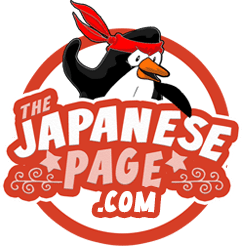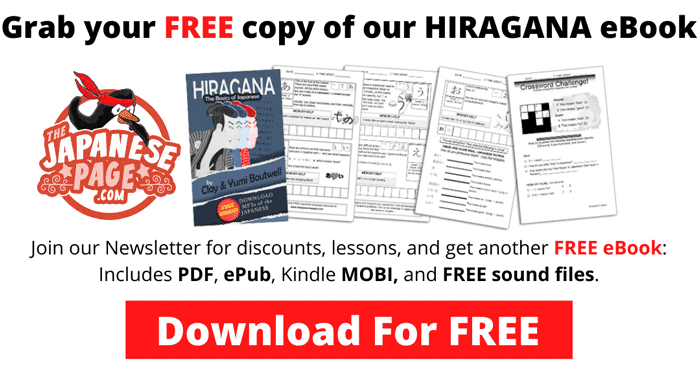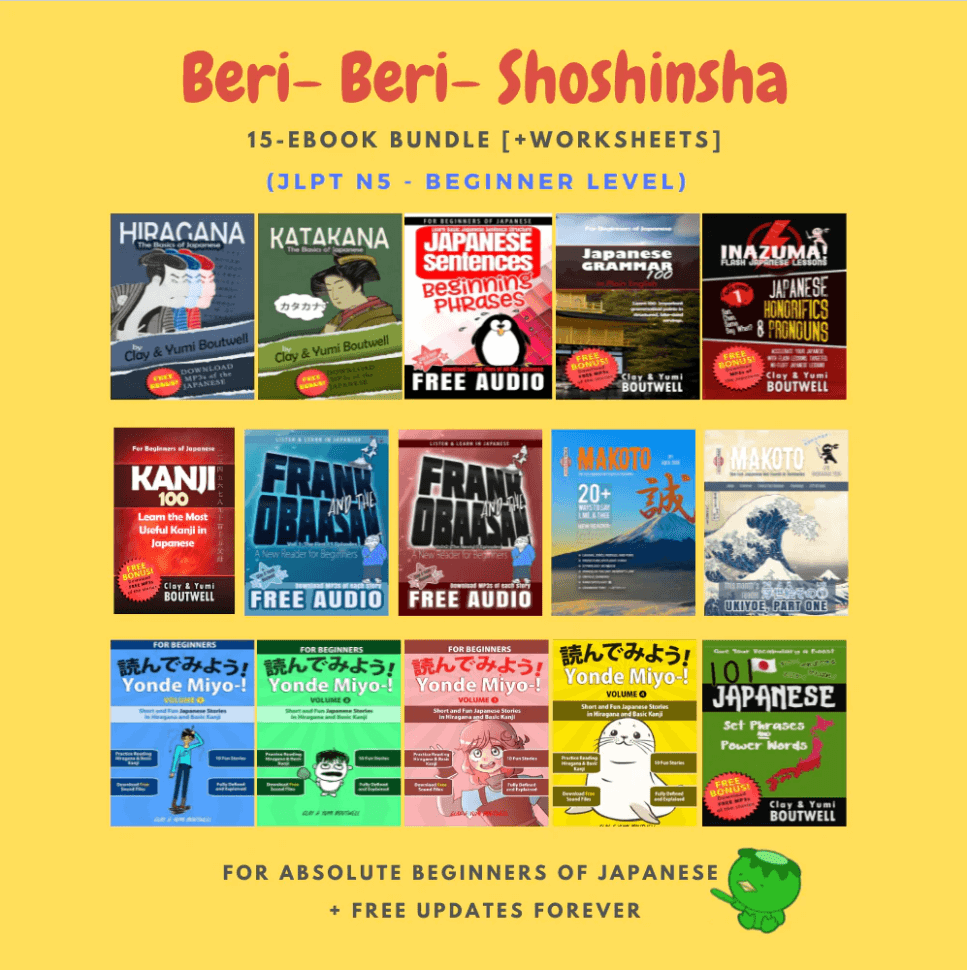
Hiragana is the foundation of the Japanese language and can be a tricky script to learn. But with our all-in-one hiragana master lesson, you'll be able to pick up the basics easily and quickly. From sound recordings and quizzes, to printable worksheets and helpful mnemonics, discover hiragana and start your journey with Japanese!
Looking for sound files to learn Japanese pronunciation, a hiragana chart, or free and printable hiragana worksheets for mastering hiragana? Want it all for free? Read on!
First, if you use the free Anki flashcard program, click here to download a free Hiragana / Katakana deck. This was generously created by Scott.
Learn Hiragana
Unless you are going to Japan next week (in which case, you may just want to learn a few basic phrases), we highly recommend spending a few hours memorizing hiragana and then a few days practicing the characters until you've learned them.
If you are serious about learning Japanese, you will need a textbook to keep your learning structured. And...most textbooks require hiragana prior to beginning. Therefore, hiragana truly is the starting point for most students.
We have good news for you:

Learning Hiragana is Not Hard
Before we get started, I want you to read the sentence above and believe it. Visualize yourself a week from now reading real Japanese. Yes, real Japanese.
While you will still need to learn katakana (easy as hiragana) and begin working with kanji (somewhat more complicated) in order to read native-level Japanese, hiragana is easy to learn and immediately (and forever) useful.

Learn Hiragana Fun Facts
In this free hiragana course, you will learn all the kana in three steps:
In each section, you will have a download link to grab the worksheets for that section. Every other section will have a quick quiz for you to test what you have learned.
But first, if you have a printer handy, click the image below and print out the hiragana chart so you can have it for easy reference.
To help gamify the experience, we will include a progress bar after each section. Congratulations! You've earned 5% progress points for reading the above and printing the chart (or at least keep the image file handy). Yeah!
Okay, let's get started to earn more points toward completion of the course.
Behold, STEP ONE!
1
The Sounds
Familiarize yourself with the sounds of Japanese
Wait! I want to read hiragana. Why do I have to...
Stop right there. Hiragana (and katakana) are all about sound. And if you don't get the correct sounds down from the beginning, you will create bad habits that will hamper your ability in the future. So, spend some time with this section. It will not only greatly help you learn hiragana but also Japanese in general.
View the videos below and listen to the sound files over and over until you get a good feel for the sounds.
If you look at the hiragana chart (you did download/print it, didn't you?), you will notice the first five characters (starting to the left) are the vowels a, i, u, e, o.

Get your Hiragana Chart handy and watch the video below of Yumi pronouncing each of the vowels. Don't worry about the actual characters yet. Concentrate on the sounds.
Mimic her mouth movements and try your best to echo her pronunciation as perfectly as possible. Keep watching and repeating until you feel like you know the sounds and the order.
Did you watch the video several times? Did you mimic the mouth movements and the sounds?
Great! Now, look at the next set on the Hiragana Chart. This is the "K" row. It follows the same vowel order as the first but adds a "k" sound to the vowel. Again, watch, mimic, and repeat.
In this next set, you'll find one small surprise. You might expect し to be pronounced "si" but it is "shi" (sounds like the English feminine pronoun "she").
Japanese has very few pronunciation irregularities, but just take them in stride. As with the sets above, listen to them until the sounds and order are natural to your ears. Repeat. Repeat. Repeat!
Now that you have the hang of it, listen to the rest of the sets. Mimic Yumi's mouth position and the sounds. Repeat until you can say it naturally in order. (I mean it! Repeat until the sounds flow from your mouth like golden melted theater popcorn butter.)
In the next one, note that the "hu" sounds more like "fu":
Can you say all the main sounds now? Try your best to learn all the sounds in order. Keep practicing until you can say each row correctly from memory.
Got it? Good. Now click on the sound button below and say the sounds with Yumi in order and with careful pronunciation.
2
The 46 Main Characters
Let's memorize the main hiragana.
Row One: あいうえお

You will spend most of your time in this section. Step 3 will simply add to what you will learn here.
Let's start with the very first row--the vowels.
Remember the sounds? A-I-U-E-O
Can you say them correctly? ah-ee-oo-eh-oh
For each hiragana, we will give you a mnemonic. The trick is to come up with a mnemonic that you can visualize. The weirder and more personal the better. If you can think of something better for you, by all means, use that mnemonic.
We will also give you an example word made up of a hiragana you have already studied (not many to begin with!). Practice reading and listen to the sound file to make sure you got the correct pronunciation.

Mnemonic:
- It looks like a cross with a sideways number 9. “Ah, number nine.”
- Ah! It looks like a “t” with a slanted "g.”
- If you look at the bottom left, you may see a lowercase "a." And if you look at the dead center, you may see a slanted capital "A."

3 strokes
Draw from left to right; top to bottom
Example Word:

Mnemonic:
- It looks like two dangling fEEt.
- It looks like a headless monster swinging his arms at you. EEk!
2 Strokes

Example Words:

Mnemonic:
- It looks like a nose and an opened mouth looking for fOOd.
- There is also a sideways "u" there to remind you of the sound.
2 Strokes

Example Words:

Mnemonic:
- hEy! It’s a man running.
3 Strokes
Example Word:

Mnemonic:
- It looks like the あ but Oh! it is sO different.
- Oh, there is an "o" at the bottom left.
Don't confuse this with the first hiragana, あ. あ has a lowercase "a' at the bottom left area and the お has an "o" there.
3 Strokes

Example Word:
Congratulations! You've just added 5% more to your progress bar. While writing the characters in the worksheet isn't 100% necessary, it is recommended. If you write each kana, be sure to say the sound and mentally visualize the strange mnemonic you've come up for it as you write it. (Combining multiple senses helps with memory.)
Row Two: かきくけこ

Now that you have learned the vowels [あいうえお], let’s build from them!
The remaining hiragana (except one) are sounds we would write with two or more letters (one consonant and one vowel) in English.
This chapter begins the “k” row. For example, か is “k” + “a” or “ka.” See? With the alphabet, it would be written with two letters. But in hiragana, it is just one character.

Mnemonic:
- It looks like a a "K" with the top falling off. Just remember to add the "A" sound: KA
3 strokes
Example Words:

Mnemonic:
- It looks like a skeleton KEY.
- It is a tree with the roots exposed (Tree in Japanese is き).
4 Strokes [Note: sometimes the bottom is written connected and sometimes it isn't. Both are correct.]


Example Words:

Mnemonic:
- It looks like paKU man (Pac-man™)
- It is the opened beak of a pigeon COOing.
1 Stroke (start from the top and go down)

Example Words:

Mnemonic:
- It looks like a broken old KEttle.
- It is the entrance of a dark CAve.
3 Strokes


Example Word:

Mnemonic:
- It is a COla can rolling on its sides.
2 Strokes
Example Word:
Congratulations! You've just added 5% more to your progress bar.
Before you move on, spend a few minutes reviewing the above hiragana. Repeat and visualize the strange mnemonic and practice saying the sound of the hiragana you see as you scroll up this page. When you are ready, click the Practice graphic below to take a quick quiz.
Did you miss any of the questions? If so, mark those down for further review. If you got 80% correct, feel free to move on. Otherwise, spend more time reviewing the mnemonics for each character.
Row Three: さしすせそ

Be sure you know the above ten hiragana before moving on. This set includes one hiragana that looks similar to a previous one. It also includes our first irregular pronunciation. Nothing too crazy!
If you are ready, read on.

Mnemonic:
- It is a SArgeant barking orders.
- It looks like a き, but no! It is a SIgn stuck in the ground.
Note: Don't confuse this with ki き. Like き, however, sometimes the bottom is attached (as in the stroke image below) and sometimes it isn't (as in the main image).
3 strokes
Example Words:

Mnemonic:
- It looks like a girl with wind in her hair. SHE has beautiful hair.
NOTE: You may (should) be expecting "si" instead of "shi." Just note this exception.
1 Stroke

Example Words:

Mnemonic:
- It is a girl named SUE wearing a hat.
2 Strokes
Example Words:

Mnemonic:
- It is a person with a hat and an open mouth SAYing something.
3 Strokes

Example Word:

Mnemonic:
- It is SO abstract, it could be a picaSO.
1-2 Strokes [This is sometimes written with the first top stroke by itself and the rest as the second stroke (see the alternate writing below). Or sometimes it is written as a single stroke. Either is fine.]
Note, this can also be written like this:
Example Word:
Congratulations! You've just added 5% more to your progress bar.
Before you move on, spend a few minutes reviewing the above hiragana. Repeat and visualize the strange mnemonic and practice saying the sound of the hiragana you see as you scroll up this page.
Row Four: たちつてと

Previously, you experienced a mild irregularity. し is shi and not si. This row has two major irregularities. Pay attention to ち and つ.
If you are ready, read on.

Mnemonic:
- It looks like a TOddler reacher for a toy.
- It looks like a "t" and half an "a": TA!
4 strokes
Example Words:

Mnemonic:
- It is a CHEAp version of the number 5.
NOTE: You may (should) be expecting "ti" but it is "chi."
2 Strokes
Example Words:

Mnemonic:
- It looks like a TSUnami wave.
Again, you may be expecting "tu" but it is "tsu." This pronunciation is tricky. Listen to the sound files. Say the words “cat” and “soup” together quickly to approximate it: caTSOUp
We will bring it up again in Part III, but a small っ causes a pause or skip in sound in certain words. Just note the small っ exists and we'll look at it closer soon.
1 Stroke
Example Words:

Mnemonic:
- It looks like a TErrible #7
- It looks like a cursive T. Surely, the next letter is an "e": TE
1 Stroke [We broke it down into two below, but write it with one stroke.]

Example Word:

Mnemonic:
- It looks like someone's big TOE.
2 Strokes

Example Word:
Congratulations! You've just added 5% more to your progress bar. Now you are ready for another practice exercise.
Did you get 80% or more correct? If so, continue on. If not, spend more time visualizing the strangest mnemonics your brain can come up with.
Row Five: なにぬねの

Now we come to the "n" row. There should be no surprises here. Just come up with solid mnemonics and learn them.
If you are ready, read on.

Mnemonic:
- It looks like a tangled KNOt.
4 strokes
Example Words:

Mnemonic:
- It is a person sitting on his KNEEs.
3 Strokes
Example Words:

Mnemonic:
- It looks like an あ, but it has a tail and a NEW hat.
2 Strokes
Example Words:

Mnemonic:
- If you look carefully, you will see a "1," a "+," and a "2," but NAY, you will not see a "3."
- It looks like a cat (NEko in Japanese) with a curled tail.
3 Strokes
Example Word:

Mnemonic:
- It looks like a #9 on its side. German for "no" is nein (pronounced "nine").
1 Stroke

Example Word:
Congratulations! You've just added 5% more to your progress bar.
Before you move on, spend a few minutes reviewing the above hiragana. Repeat and visualize the strange mnemonic and practice saying the sound of the hiragana you see as you scroll up this page.
Row Six: はひふへほ

Two of these hiragana (は and へ) are used both as sounds and as particles. When used as a particle, they both have a different sound.
If you are ready, read on.

Mnemonic:
- It looks like a man with a hat smoking a HOt pipe. HA!
NOTE: This hiragana is "ha," however, when used as the topic particle, it is pronounced as "wa."
3 strokes

Example Words:

Mnemonic:
- It looks like a smiley face laughing, "HEE HEE".
1 Stroke


Example Words:

Mnemonic:
- It looks like a snake looking for FOOd.
NOTE: the bottom two dashes are sometimes written as a single horizontal line as in the stroke diagram.
Sometimes this is written as "hu" (especially by native Japanese speakers), but the sound is closer to a "fu."
4 Strokes

Example Words:

Mnemonic:
- HEY! It's an upside down V.
NOTE: When used as a directional particle, this is usually pronounced as "e."
3 Strokes

Example Word:

Mnemonic:
- HO OH! It is more complicated than は.
Don't confuse this with は (ha). ほ is the only one that has a horizontal line at the very top. The top line in は and ま and も are down a little.
4 Strokes


Example Word:
Congratulations! You've just added 5% more to your progress bar. Let's review with a quick practice quiz.
As always, if you got 80% correct, you can move on. If not, spend a little more time associating the mnemonic, hiragana, and its sound.
Row Seven: まみむめも

Mnemonic:
- Look MA! I caught a dragonfly.
NOTE: Don't confuse this with ほ (ho) or は (ha). ま has two horizontal lines and no vertical line to the left.
3 strokes

Example Words:

Mnemonic:
- To ME, it looks like a 2 over a 4.
2 Strokes

Example Words:

Mnemonic:
- It looks like an old film projector showing a MOvie.
- It is a cow wagging its tail and saying MOO.
3 Strokes


Example Words:

Mnemonic:
- It looks like a half-closed eye. (In Japanese, eye is pronounced "me.")
2 Strokes


Example Word:

Mnemonic:
- A man with a hat resting after MOWing his yard.
3 Strokes


Example Word:
Congratulations! You've just added 5% more to your progress bar.
Before you move on, spend a few minutes reviewing the above hiragana. Repeat and visualize the strange mnemonic and practice saying the sound of the hiragana you see as you scroll up this page.
Row Eight: やゆよ
This row only has three characters, but learn these well. In the next section, we'll see how these hiragana can be combined with other hiragana to produce new sounds. There are no yi or ye sounds in modern Japanese.
We'll look at the small や ya, ゆ yu, よ yo closer in Part III, but here is a quick overview:
o These small “y” kana are combined with a full-sized hiragana. For example: き ki + small や ya = きゃ kya
o Although one and a half kana long when written, the length of the sound is still only one mora. (kya instead of “kiya”)
o Therefore とうきょう (Tokyo) is Tou – kyou [both syllables (“tou” and “kyou”) are long and the “kyo” is a single syllable. It isn’t “To - ki - yo” but “Tou – kyou”]
o じゆう jiyuu (freedom) -> じゅう jyuu* (ten) [*I normally would write “jyuu” in rōmaji as “juu” because that is how it sounds, but “jyuu” allows us to see the combination clearly; also, note the number of moras: ji-yu-u (freedom - three moras) versus jyu-u (ten - two moras)]

Mnemonic:
- A YAcht with its sail blowing in the wind.
3 strokes


Example Words:

Mnemonic:
- If you look closely, you may see a "y," "o," and "u." That spells "you."
2 Strokes

Example Words:
Congratulations! You've just added 5% more to your progress bar.
Before you move on, spend a few minutes reviewing the above hiragana. Repeat and visualize the strange mnemonic and practice saying the sound of the hiragana you see as you scroll up this page.
Row Nine: らりるれろ

Pay special attention to the R sounds. These are the hardest for native English speakers to master.
o These sound like a mixture of R’s and L’s and D’s.
o In English, to make a slightly exaggerated “ra” sound, your tongue slaps against the roof of your mouth. Go ahead and try it a few times. See what I mean?
o To make a “da” sound, your tongue slaps against the bottom of your top teeth.
o The Japanese sounds are somewhere in between. Place your tongue on the roof of your mouth just before teeth and say RA – RI – RU – RE – RO.

Mnemonic:
- Looks like a RAttled #5.
3 strokes

Example Words:

Mnemonic:
- It looks like two arms REAching for something
Note: this can be written as two separate lines (the main example) or connected (as in the stroke example).
2 Strokes

Example Words:

Mnemonic:
- It looks like a ROOt
1 Stroke

Example Words:

Mnemonic:
- It is almost the shape of a RAInbow.
- It is a snake REsting on a branch.
2 Strokes


Example Word:

Mnemonic:
- A man ROWing his boat.
Don't confuse this with る. When you ROW your boat, you don't need a loop at the end.
2 Strokes

Example Word:
Congratulations! You've just added 5% more to your progress bar.
Before you move on, spend a few minutes reviewing the above ten hiragana. Repeat and visualize the strange mnemonic and practice saying the sound of the hiragana you see as you scroll up this page.
Row Ten: わをん

Mnemonic:
- It is a bulging WAshing machine.
Don't confuse this with れ or ね. The わ does not have a loop and the bulge comes inside instead of out.
3 strokes

Example Words:

Mnemonic:
- It looks like a cursive "n":
This is the only hiragana with no vowel sound.
1 Stroke

Example Word:
Congratulations! You've gone through all of the 46 main characters. You've made considerable progress and you only have a little more to go. Do the practice below to test your reading ability of the above 46 characters. If you get 80% or more correct, go to Step Three.
3
Beyond the 46 - Wrapping Things Up
The small characters, small dashes, and circles.
- The small っ- (adds a short pause between sounds)
- The small や, ゆ, and よ - (adds a ya, yu, or yo sound to a consonant)
- Dakuten (quote-like marks) - (makes a sound harder: "ka" becomes "ga")
- Handakuten (circle mark) - (makes a p sound: "ha" becomes "pa")
The Small っ
a small つ tsu is used to cause a short pause or break between syllables. For example, in English we have a slight pause after “black” in “black car.” Here is a good example to show how important this small つ is.
がっき gakki - musical instrument [with a slight pause] and がき gaki - brat, annoying kid [without the pause]
Remember: The small つ is not pronounced, but causes a short hiccup between sounds
The Small や, ゆ, and よ
There is a pattern.
In every case, a consonant sound is combined with a small や ya, ゆ yu, or よ yo. And the consonant sound has already been decided for you! It is always those under the “i” column. Look at the chart we gave you earlier. Starting with the “k” row, we see き, し, ち, に, ひ, み, and り are used. (all i’s)
Now, notice the sound changes. き ki + や ya = きゃ kya [just remove the "i"]
Easy isn’t it? You can think of the smaller や, ゆ, or よ as taking away the “i” sound in the first character. You may be saying, “What is the difference between きや kiya and きゃ kya?” First, the sound is different. “KI YA” (two syllables) versus “KYA” (one syllable). Second, the meaning can be totally different.

NOTE: We didn’t write the し and ち rows with a “y” in the romaji. If we were to write sya (as many Japanese people do) the sound to the foreigner will be different. Both ways are correct—One being more “correct” to the Japanese understanding of the writing system and the other being more “correct” to the pronunciation.
Dakuten & Handakuten
The dakuten or “ten ten” makes a soft sound harder. For example, it makes a “k” sound a hard “g” sound (“g” as in good). “s” becomes “z,” “t” becomes “d,” and “h” becomes “b.”
The o or “maru” makes the “h” become a “p” sound. The other consonant sounds are not affected by the maru, only the “h” group. That’s all there is to it!
See how easy it is? All you have to remember is:
"k" becomes "g"

"s" become "z"
(note the じ sounds like "ji" instead of "zi")
"t" becomes "d"
(note the ぢ and づ have irregular pronunciations; also, to write these two characters, type them as if they were pronounced according to the pattern: di = ぢ and du = づ)
h “ b
h o p
NOTE: There are two sets with the same pronunciation with the ten ten. じ & ぢ are both pronounced ji’ and ず & づ are both zu. While all four characters do appear in words (and are not interchangeable) the じ is more common than ぢ and the ず is more common than づ. Think of ji as じ and zu as ず and learn the exceptions as you come to them.
You did it!
Now, try our 50 word hiragana quiz to practice recognizing the characters.
Once you've done that then try reading this story here. You can read the story in hiragana (with spaces) or in full Japanese with beginner-level kanji.
And if you like that story or would like to have more practice (in addition to getting instant access to several books on beginner-level Japanese), check out our Beri- Beri- Shoshinsha Beginner's Bundle over at TheJapanShop.com. It includes a dozen resources to take your Japanese to the next level. (Plus, Yumi and I will greatly appreciate it!)
















